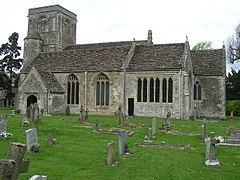Population 983 Sovereign state United Kingdom Local time Wednesday 1:57 PM District Mendip | OS grid reference ST801518 Post town FROME Dialling code 01373 | |
 | ||
Weather 8°C, Wind S at 14 km/h, 83% Humidity | ||
Beckington is a village and civil parish in the Mendip district of Somerset, England, across the River Frome from Lullington about three miles north of Frome. According to the 2011 census the parish, which includes the hamlet of Rudge, had a population of 983.
Contents
- Map of Beckington Frome UK
- History
- Governance
- Transport
- Education
- Landmarks
- Religious sites
- Standerwick
- Notable people
- References
Map of Beckington, Frome, UK
The parish includes the hamlet of Standerwick.
History
Beckington is mentioned in the Domesday Book.
The parish was part of the hundred of Frome.
During the medieval period it became a centre for the wool trade. By the 15th century, fulling mills had been built along the banks of the River Frome which supported spinning and weaving cottage industries.
In September 1766, rioters marched to Beckington and set on fire a mill and other property, in spite of being offered money and parish relief for their families.
Governance
The parish council has responsibility for local issues, including setting an annual precept (local rate) to cover the council’s operating costs and producing annual accounts for public scrutiny. The parish council evaluates local planning applications and works with the local police, district council officers, and neighbourhood watch groups on matters of crime, security, and traffic. The parish council's role also includes initiating projects for the maintenance and repair of parish facilities, as well as consulting with the district council on the maintenance, repair, and improvement of highways, drainage, footpaths, public transport, and street cleaning. Conservation matters (including trees and listed buildings) and environmental issues are also the responsibility of the council.
The village falls within the Non-metropolitan district of Mendip, which was formed on 1 April 1974 under the Local Government Act 1972, having previously been part of Frome Rural District, which is responsible for local planning and building control, local roads, council housing, environmental health, markets and fairs, refuse collection and recycling, cemeteries and crematoria, leisure services, parks, and tourism.
Somerset County Council is responsible for running the largest and most expensive local services such as education, social services, libraries, main roads, public transport, policing and fire services, trading standards, waste disposal and strategic planning.
The village falls in the 'Beckington and Selwood' electoral ward. The ward stretches from Beckington south to East Woodlands but avoiding Frome. The total population of the ward at the 2011 census was 2,125.
It is also part of the Somerton and Frome county constituency represented in the House of Commons of the Parliament of the United Kingdom. It elects one Member of Parliament (MP) by the first past the post system of election, and part of the South West England constituency of the European Parliament which elects seven MEPs using the d'Hondt method of party-list proportional representation.
Transport
Beckington was on the A36 until a bypass was built in 1989.
Education
Beckington school is a Church of England Voluntary Controlled First School which was built in 1852. Springmead Preparatory School is also based in the village.
Landmarks
Seymours Court Farmhouse dates from the 15th century and is Grade I listed. It was once the home of Thomas Seymour, 1st Baron Seymour of Sudeley, who married Queen Catherine Parr.
Beckington Castle, which housed Ravenscroft School between 1945 and 1970, was originally built in the 17th century. It is now home to a company providing technical and procurement support to the Ministry of Defence. The Wool Hall, next door, dates from the 16th century, was substantially restored in the 19th century, and served as a recording studio from the early 1980s until its closure in 2004.
The cottages along Church Street date from around 1720.
Like the Wool Hall, the Woolpack Inn took its name from the village trade and opened as a coaching inn in the 16th century, but the current building was rebuilt on the site in the late 18th.
Beckington is also home to two village pumps. One of these described as "smart", is near the church under a hooded wooden structure, whilst the other, described as "altogether less grand", is located on a parkway.
Religious sites
It has a Norman Church of St George dating from the 14th century. The tower contains two bells dating from 1756 and made by Thomas Bilbie of the Bilbie family. It has been designated by English Heritage as a Grade I listed building.
The Abbey, Beckington, dating from 1502, is a former monastic grange and college for priests later adapted as a house.
Standerwick
The hamlet of Standerwick within the parish of Beckington includes the Frome Agricultural Market and has one public house, The Bell. Its existence is recorded as far back as 1660. Buildings include Standerwick Court, a manor house in the grounds of which is said to be an ancient encampment, perhaps a connecting station between Bath and King Alfred's Tower at Stourton.
Foxes Drove Farm dates from around 1750.
